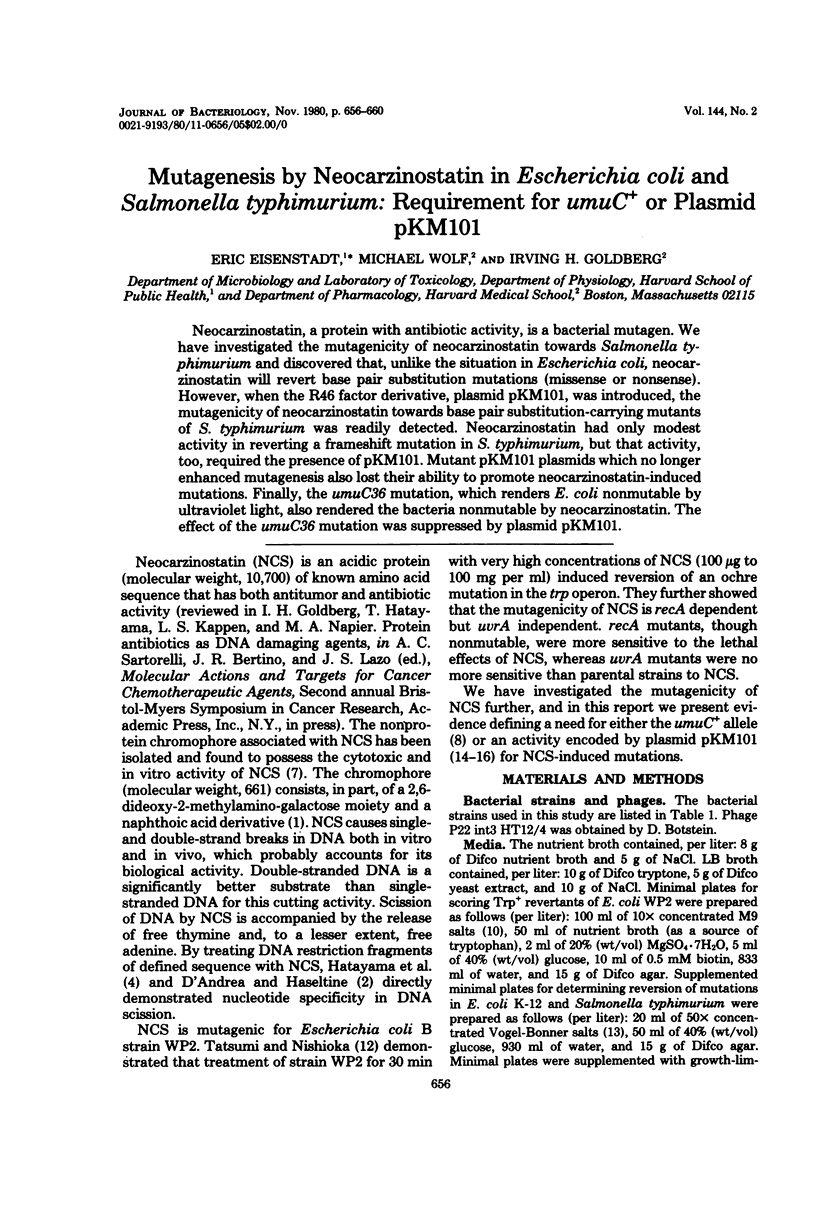Abstract
Neocarzinostatin, a protein with antibiotic activity, is a bacterial mutagen. We have investigated the mutagenicity of neocarzinostatin towards Salmonella typhimurium and discovered that, unlike the situation in Escherichia coli, neocarzinostatin will revert base pair substitution mutations (missense or nonsense). However, when the R46 factor derivative, plasmid pKM101, was introduced, the mutagenicity of neocarzinostatin towards base pair substitution-carrying mutants of S. typhimurium was readily detected. Neocarzinostatin had only modest activity in reverting a frameshift mutation in S. typhimurium, but that activity, too, required the presence of pKM101. Mutant pKM101 plasmids which no longer enhanced mutagenesis also lost their ability to promote neocarzinostatin-induced mutations. Finally, the umuC36 mutation, which renders E. coli nonmutable by ultraviolet light, also rendered the bacteria nonmutable by neocarzinostatin. The effect of the umuC36 mutation was suppressed by plasmid pKM101.
Full text
PDF




Selected References
These references are in PubMed. This may not be the complete list of references from this article.
- Albers-Schönberg G., Dewey R. S., Hensens O. D., Liesch J. M., Napier M. A., Goldberg I. H. Neocarzinostatin: chemical characterization and partial structure of the non-protein chromophore. Biochem Biophys Res Commun. 1980 Aug 14;95(3):1351–1356. doi: 10.1016/0006-291x(80)91622-8. [DOI] [PubMed] [Google Scholar]
- Ames B. N., Lee F. D., Durston W. E. An improved bacterial test system for the detection and classification of mutagens and carcinogens. Proc Natl Acad Sci U S A. 1973 Mar;70(3):782–786. doi: 10.1073/pnas.70.3.782. [DOI] [PMC free article] [PubMed] [Google Scholar]
- D'Andrea A. D., Haseltine W. A. Sequence specific cleavage of DNA by the antitumor antibiotics neocarzinostatin and bleomycin. Proc Natl Acad Sci U S A. 1978 Aug;75(8):3608–3612. doi: 10.1073/pnas.75.8.3608. [DOI] [PMC free article] [PubMed] [Google Scholar]
- Hartman P. E., Hartman Z., Stahl R. C. Classification and mapping of spontaneous and induced mutations in the histidine operon of Salmonella. Adv Genet. 1971;16:1–34. doi: 10.1016/s0065-2660(08)60352-1. [DOI] [PubMed] [Google Scholar]
- Hatayama T., Goldberg I. H., Takeshita M., Grollman A. P. Nucleotide specificity in DNA scission by neocarzinostatin. Proc Natl Acad Sci U S A. 1978 Aug;75(8):3603–3607. doi: 10.1073/pnas.75.8.3603. [DOI] [PMC free article] [PubMed] [Google Scholar]
- Howarth S. Increase in frequency of ultraviolet-induced mutation brought about by the colicine factor, col-I in Salmonella typhimurium. Mutat Res. 1966 Apr;3(2):129–134. doi: 10.1016/0027-5107(66)90026-1. [DOI] [PubMed] [Google Scholar]
- Howarth S. Resistance to the bactericidal effect of ultraviolet radiation conferred on Enterobacteria by the colicine factor coli. J Gen Microbiol. 1965 Jul;40(1):43–55. doi: 10.1099/00221287-40-1-43. [DOI] [PubMed] [Google Scholar]
- Kappen L. S., Napier M. A., Goldberg I. H. Roles of chromophore and apo-protein in neocarzinostatin action. Proc Natl Acad Sci U S A. 1980 Apr;77(4):1970–1974. doi: 10.1073/pnas.77.4.1970. [DOI] [PMC free article] [PubMed] [Google Scholar]
- Kato T., Shinoura Y. Isolation and characterization of mutants of Escherichia coli deficient in induction of mutations by ultraviolet light. Mol Gen Genet. 1977 Nov 14;156(2):121–131. doi: 10.1007/BF00283484. [DOI] [PubMed] [Google Scholar]
- McCann J., Spingarn N. E., Kobori J., Ames B. N. Detection of carcinogens as mutagens: bacterial tester strains with R factor plasmids. Proc Natl Acad Sci U S A. 1975 Mar;72(3):979–983. doi: 10.1073/pnas.72.3.979. [DOI] [PMC free article] [PubMed] [Google Scholar]
- Piszkiewicz D., Tilley B. E., Rand-Meir T., Parsons S. M. Amino acid sequence of ATP phosphoribosyltransferase of Salmonella typhimurium. Proc Natl Acad Sci U S A. 1979 Apr;76(4):1589–1592. doi: 10.1073/pnas.76.4.1589. [DOI] [PMC free article] [PubMed] [Google Scholar]
- Tatsumi K., Nishioka H. Effect of DNA Repair systems on antibacterial and mutagenic activity of an antitumor protein, neocarzinostatin. Mutat Res. 1977 Apr;48(2):195–203. doi: 10.1016/0027-5107(77)90161-0. [DOI] [PubMed] [Google Scholar]
- VOGEL H. J., BONNER D. M. Acetylornithinase of Escherichia coli: partial purification and some properties. J Biol Chem. 1956 Jan;218(1):97–106. [PubMed] [Google Scholar]
- Walker G. C., Dobson P. P. Mutagenesis and repair deficiencies of Escherichia coli umuC mutants are suppressed by the plasmid pKM101. Mol Gen Genet. 1979 Apr 17;172(1):17–24. doi: 10.1007/BF00276210. [DOI] [PubMed] [Google Scholar]
- Walker G. C. Isolation and characterization of mutants of the plasmid pKM101 deficient in their ability to enhance mutagenesis and repair. J Bacteriol. 1978 Mar;133(3):1203–1211. doi: 10.1128/jb.133.3.1203-1211.1978. [DOI] [PMC free article] [PubMed] [Google Scholar]
- Walker G. C. Plasmid (pKM101)-mediated enhancement of repair and mutagenesis: dependence on chromosomal genes in Escherichia coli K-12. Mol Gen Genet. 1977 Mar 28;152(1):93–103. doi: 10.1007/BF00264945. [DOI] [PubMed] [Google Scholar]


